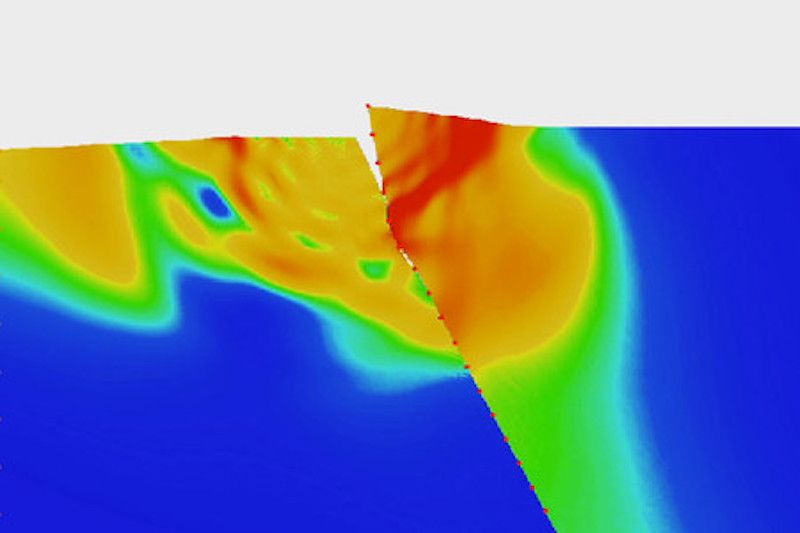Mega-Quakes Can Cause Earth’s Crust to Rip Open and Snap Shut

Like a crocodile's jaw opening and snapping shut, Earth's crust can rip apart and then violently close back up during an earthquake, a new study finds. The discovery refutes previous claims that this kind of phenomenon was impossible, and the new research could potentially require that current seismic maps be redrawn.
The study focused on a particular paradox associated with thrust faults, a crack in Earth’s crust, where geologic forces are slowly pushing a huge slab of continental crust up and over an oceanic layer.
"For a long time, it was assumed that thrust faults, subduction zone faults being a class of such faults, could not have a large amount of slip close to the Earth's surface," said Harsha Bhat, a research scientist at the École Normale Supérieure (ENS) in Paris and co-author of the new study with California Institute of Technology graduate student Vahe Gabuchian. [The 10 Biggest Earthquakes in History]
A dormant hypothesis
The assumption was made because as the continental slab grinds over the oceanic one below, it scrapes off the soft surface clay and leaves it piled up in the subduction zone. Geologists thought that any energy generated from a seismic event within the thrust fault would peter out once it hit the soft clay and that a large slip wouldn't happen near the surface.
But clues from past earthquakes suggested otherwise, said Christopher Scholz, a professor of geophysics at Columbia University's Lamont-Doherty Earth Observatory in New York City. The San Fernando earthquake that occurred in 1971, for example, left behind an unusual pile of debris that anyone can still see today, said Scholz, who was not involved with the new study.
"It's right at the base of a mountain," he said. "The thrust comes out at a low angle, and it looks like [the earthquake] flapped the whole soil layer, just flipped it over below the fault."
How did the earthquake cause such a giant amount of material to flip over if the energy dissipated in the clay?
Sign up for the Live Science daily newsletter now
Get the world’s most fascinating discoveries delivered straight to your inbox.
Geophysicist James Brune, then at the University of Nevada was the first scientist to attempt to answer that question in a 1996 study he published in the Proceedings of the Indian Academy of Science, Scholz said. Brune figured it was the result of some kind of torquing action in the fault. He conducted an experiment using foam rubber that showed the energy of a simulated earthquake propagating down a fault and flipping the tip — as if some large hand were cracking a whip.
"I don't think people believed it," Scholz said. "They thought this was some weird thing that had to do with foam. They didn't take it seriously."
For decades, the idea lay dormant, he said.
But clues from subsequent earthquakes continued to suggest that Brune had been on to something. In their new paper, Bhat, Gabuchian and their colleagues cited the 1999 magnitude-7.7 earthquake in Chi-Chi, Taiwan, that caused billions of dollars in structural damage and killed more than 2,000 people. They also pointed to the magnitude-9.0 earthquake in Tohoku-Oki, Japan, that damaged the Fukushima Daiichi Nuclear Power Plant in 2011.
New clues
Geophysicists who analyzed the faults after the earthquakes could not find signs of stress at the boundary between the soft clay and harder rock.
"How can it slip without stress?" Scholz said. "That's the big mystery."
And it's a mystery that Gabuchian and his colleagues think they have solved. The researchers performed an experiment similar to Brune's from 1996, but they did not use foam.
Instead, the scientists used a transparent block of plastic that has mechanical properties similar to those of rock, and conducted experiments in Caltech's earthquake laboratory, nicknamed the "Seismological Wind Tunnel," a facility that can simulate and image laboratory-generated temblors.
The researchers cut the plastic block in half and then forced them together, simulating the tectonic pressure of two slabs of Earth's crust pressing against each other. Next, they placed a wire fuse where they envisioned the epicenter of an earthquake and then lit the fuse.
Instantly, a rupture propagated down the fault line, and when it hit the surface, the fault twisted open and then snapped shut.
The snapping action reduces the stress that keeps both sides of a fault pressed together, said Bhat. Less pressure makes it easier for a slab of rock to slide.
“Hence you can have large amount of shallow slip,” he said.
At least for the magnitude-9.0 earthquake in Tohoku-Oki, the researchers think that as the earthquake propagated up the fault, it caused one slab of rock to twist away from the other momentarily and then snap shut, causing the fault to slip more than 160 feet (50 meters).
"The snapping open is temporary," Bhat emphasized. "It's not like how it's depicted in the movies," he said.
Armed with this new information, geologists could redraw seismic maps to show where the ground might torque in future earthquakes and cause the most destruction, Scholz said. This could help cities better prepare for future events and help geologists solve mysteries about past earthquakes, he added.
Original article on Live Science.












